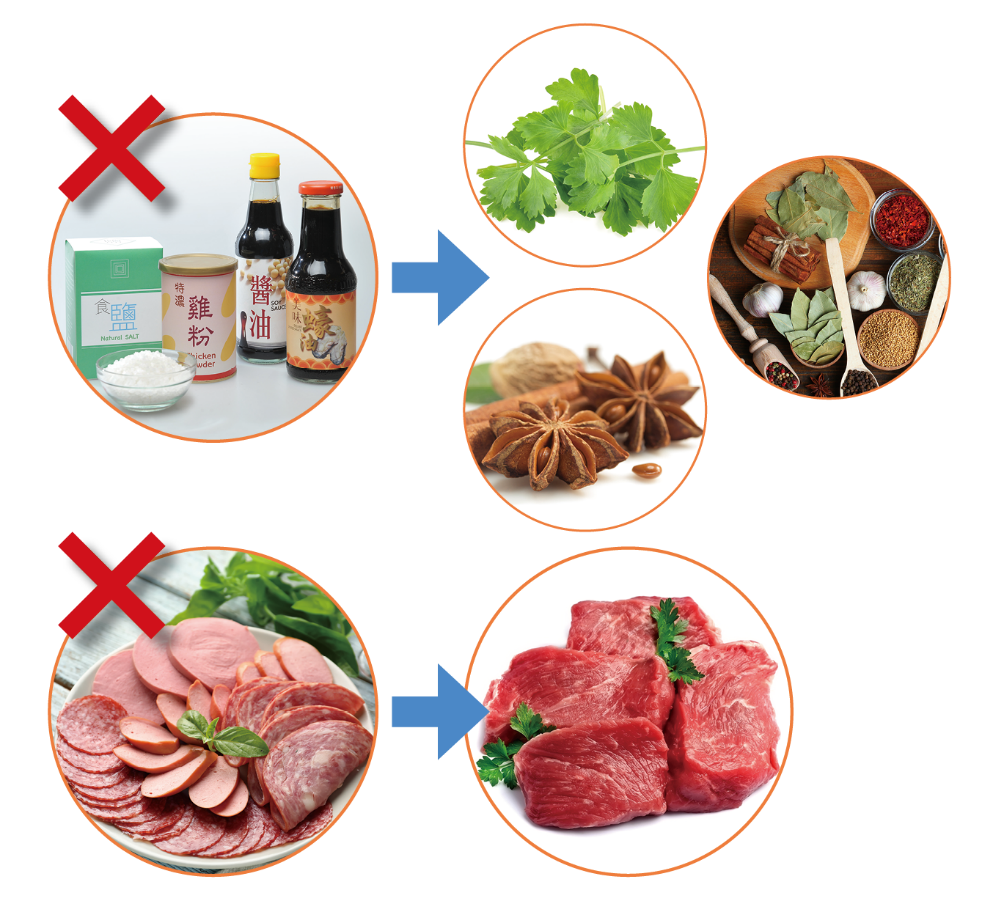
Food Safety Focus (152nd Issue, March 2019) – Food Safety Platform
Product Reformulation to Reduce Salt Content in Food (Part II)
Reported by Mr. Nicky HO, Scientific Officer
Risk Communication Section, Centre for Food Safety
In the last issue, we discussed target setting in salt/sodium reduction in food. This time, we talk about salt reduction in food through product reformulation.
Variation of Salt Content in Food
The Centre for Food Safety (CFS) regularly conducts studies on nutrient content in different food products in Hong Kong. The study results often show that within the same type of food, the salt content can vary widely. This is observed in food types, such as bread, soups, Hong Kong style savoury dishes and "Meal-on-One-Plate", reflecting the feasibility of the trade to reduce the salt content in their food products.

Product reformulation to reduce salt content in food helps reduce population salt intake and the risk of developing high blood pressure.
Product Reformulation to Reduce Salt Content in Food
The World Health Organization opines that reformulation of food products to contain less salt is among others one of the “Best Buy” intervention to reduce salt intake of the population. The CFS had published “Trade Guidelines for Reducing Sodium in Foods” to encourage the trade to produce and promote wholesome and safe food which have lower salt content.
Ways to Reduce Salt Content in Food
The trade may follow the advice in the CFS’ guidelines to reduce salt contents in food products, including:
- Choose ingredients with lower salt content. The information could be obtained from the suppliers, the nutrition labels of products or some food composition databases.
- Make reference to the salt reduction targets set by other authorities as a guide to purchase or import ingredients for manufacturing food.
- Reduce the use of salt and seasonings such as using fresh, frozen or reduced-salt canned vegetables to replace pickles or using fresh meat to replace marinated or preserved meat.
- Use natural ingredients (e.g. lemon, tomato) or herbs and spices (e.g. garlic, chilli, star anise, lemongrass, basil, etc.) for flavouring and marinating.
- Establish a database of their products so as to monitor the salt content in food.
These are concerns that reducing the salt content of food products may make the food not palatable to consumers. However, studies in Australia and the Netherlands had showed that a gradual salt reduction in bread would not affect the consumers’ choice. So if, the trade lower the salt content in food gradually without a noticeable difference in taste, better consumer acceptance is expected.
Salt Reduction in Bread
From a recent study conducted by the CFS on salt content in bread, sesame bun, white bread, wholemeal bread and sausage bun were found having relatively high salt content. The trade may reduce their salt content by purchasing butter and sausage with lower salt content and gradually reduce the salt added in the dough with acceptable change in the texture of the bread. Moreover, the study showed that there is variation in the salt content in the same bread type, reflecting that salt reduction in bread is feasible.
Salt Reduction in Soup
From the study conducted by the CFS in 2016, Tom Yum Goong soup, Hot and Sour soup and Borsch were found having relatively high salt content. The trade may reduce their salt content by using natural ingredients or herbs and spices to replace seasonings and sauce for flavouring, and using fresh meat to replace marinated or preserved meat.
Salt Reduction Target in Hong Kong
We have been discussing with the trade on product reformulation on reducing salt content in food. The CFS has started to exchange views with the trade to reduce the salt content in soup and bread to set relevant voluntary salt reduction target for the food products. The CFS will continue the work for other food products (e.g. noodles-in-soup, Hong Kong style savoury dishes and “Meal-on-One-Plate”). The government will continue to work with the food trade on reducing salt content in food and to facilitate their work on product reformulation.


